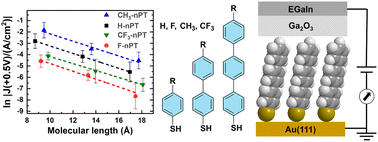Effect of substitution on the charge transport properties of oligophenylenethiolate self-assembled monolayers†
Abstract
Electrostatic effects in charge transport across the molecular framework, including those imposed by halogen atoms, have recently attracted noticeable attention of the molecular-electronics community. In this context, in the present work, we studied the effect of tail group (R) substitution on the charge transport properties of oligophenylenethiolate self-assembled monolayers (SAMs) on Au(111), with R = H, F, CH3, and CF3. The length of the molecular backbone was varied from one to three rings and the quality, basic parameters, and electrostatic properties of the SAMs were monitored. For a given length of the molecular backbone, the current density showed a strong dependence on R, being the highest for R = CH3, and then successively lower for R = H, R = CF3, and R = F. This tendency correlated neither with the molecular length of the precursors nor with the work function of the SAMs and was, therefore, exclusively ascribed to the identity of the tail group. In contrast to the current density, the tunneling decay coefficient, describing its dependence on the molecular length, was found to be independent of the identity of the tail group. The reasons behind the observed behavior are discussed and rationalized within the available experimental data and reasonable assumptions.

- This article is part of the themed collection: 2022 PCCP HOT Articles


 Please wait while we load your content...
Please wait while we load your content...